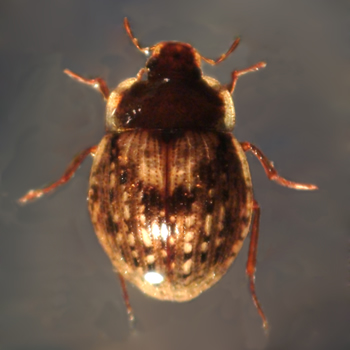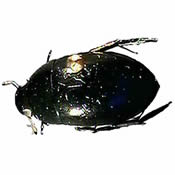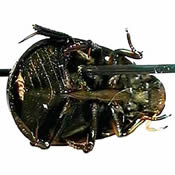| |
|
|
| Distinguishing
Characteristics |
| Family contains both freshwater and marine inhabiting speciesClub-shaped antennae (2)
Larval Features
|
| Additional Pictures |
|
|
| Ecology |
Geographic Distribution:
Commonly found in the Western hemisphere around Central and South American tropical environments. Genus Tropisternus is the most common Hydrophilidae found in South American ponds and rain pools (3). Derallus angustus is also widely distributed in the areas of Guatemala and Argentinian forests. (4) Hydrophilid beetles occupy North America, with Berosus ingeminatus reside in the seasonal wetlands of California (5) and T. lateralis in the lakes of Illinois (7).
Lentic and Lotic environment dwelling Hydrophilid beetles are found in the Mediterranean areas of Europe and Africa (1).
Habitat:
The larval and adult stages of most hydrophilid beetles are aquatic, including Tropisternus lateralis, which inhabits permanent ponds. This species prefers ponds that are fishless (6). T. lateralis have decreased oviposition levels in ponds containing fish because the beetles do not lay eggs were predatory fish reside (popup(6)). Derralus angustus and T. setiger of South America are found in permanent ponds, with D. angustus preferring ponds with dense floating Salvinia (floating fern) species (3,4). Preferred habitats often include marshy, heavily weeded shallow areas (2).
The Encrochus bicolor is a complex of five Palearctic species that are specialists that live in either marine ponds or streams. They are found in the margins of salt pans or salt streams (1).
Life History:
Derallus angustus is univoltine with three instars and two periods of enhanced productivity at the end of spring and the end of summer in Buenos Aries, Argentina (4). Tropisternus setiger also exhibits three larval instars, with a short pupae stage (3).
Physiological Ecology:
All mating and oviposition takes place in ponds for Tropisternus lateralis. Although being aquatic, adult hydrophilid beetles disperse by flight after emergence from their pupa stage, selecting a new habitat for reproduction (6). Distribution patterns are related to the cause of physiological changes in wing morphology of the Enochus bicolor species. Lentic environment inhabiting species show lower wing loading and wing aspect ratios than lotic inhabiting species to enable higher dispersal due to short-lived patterns of lentic systems. The superior flight ability of these species allows for larger distribution patterns, increasing the likelihood of survival for species that inhabit less stable lentic waters (1).
All larvae are aquatic but are restricted to shallow waters because they require oxygen from the air to survive (2). Berosus larvae have thoracic gills that allow them to stay underwater for extended periods of time giving them the ability to survive in deeper waters (2). B. ingeminatus uses cutaneous respiration in the larval stage and for air stores in adults allowing prolonged submergence. This decreases exposure to surface predation and displacement by surface agitation (7).
Feeding Ecology:
Larvae are highly avid generalist predators (6), with species B. ingeminatus being a predatory specialist of Cricotopus sylvestris and affiliated epiphytic midges (5). The covetous predatory habits of Tropisternus setiger are affected by the requirement of reaching predetermined physiological states before entering next developmental stage, with optimal prey density for development and survivorship being 4 preys per day. T. setiger larvae will counter to tactile stimuli of prey, and may drop prey while feeding in order to attain another (3).
Adult hydrophilid beetles are usually not predacious; many species are categorized as scavengers or grazers (6). Mainly feeding on vegetation, but sometimes will feed on dead animal tissue (2). Derralus angustus of South America will often graze on species of floating Salvinia (4).
Food Web Roles:
Due to the inhabitance of shallow areas, most hydrophilid beetles are affected by fish predation (6). They have also been found to be important food sources for waterfowl in seasonal wetlands of California (7).
Because Berosus ingeminatus is a predatory specialist of epiphytic midges, useful in the management of midges for waterfowl food. Since the species is a predatory specialist, B. ingeminatus does not directly impact other invertebrates that waterfowl ingest (5). |
| Videos |
- Video: Sperchopsis tessellata walking
|
| Additional Links |
|
| Bibliography |
(1) Arribas, Paula, Josefa Velasco, et al. "Dispersal ability rather than ecological tolerance drives differences in range size between lentic and lotic water beetles (Coleoptera: Hydrophilidae)." Journal of Biogeography. 39. (2012): 984-994. Print.
(2) Leech, H.B., and H.P. Chandler. "Coleoptera." Aquatic Insects of California. Ed. Robert L. Usinger. 6th. Los Angeles: University of California Press, 1974. 334-337. Print.
(3) Pereyera, Daniela, and Miguel Archangelsky. "The effect of prey density on the developmental time of larvae of an aquatic beetle: Tropisternus setiger (Insecta, Coleoptera: Hydrophilidae)." Hydrobiologia. 586. (2007): 367-372. Print.
(4) Fernandez, Liliana. "The annual life history of a population of the aquatic Coleopteran Derallus angustus (Coleoptera: Hydrophilidae)." International Journal of Tropical Biology. 56.1 (2008): 345-348. Print.
(5) Batzer, Darold, and Vincent Resh. "Trophic Interactions among a Beetle Predator, a Chironomid Grazer, and Periphyton in a Seasonal Wetland." Oikos. 60.2 (1991): 251-257. Print.
(6) Resetarits, William. "Colonization under Threat of Predation: Avoidance of Fish by an Aquatic Beetle, Tropisternuslateralis (Coleoptera: Hydrophilidae)." Oecologia. 129.1 (2001): 155-160. Print.
(7) De Szalay, Ferenc, and Vincent Resh. "Factors influencing macroinvertebrate colonization of seasonal wetlands: responses to emergent plant cover." Freshwater Biology. 45. (2000): 295-308. Print.
|
|




